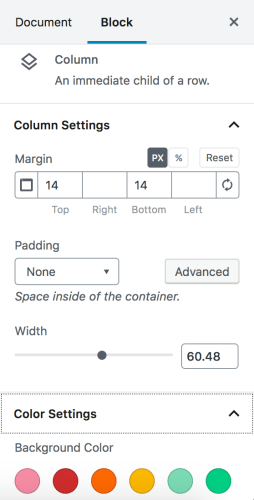CoBlocks, one of the earliest block collections for Gutenberg, has added new page building blocks and tools in the latest 1.6 release. ThemeBeans founder Rich Tabor and plugin developer Jeffrey Carandang partnered together on this iteration of CoBlocks to bring users new Row and Columns blocks and a Typography Control Panel.
The Row and Column blocks are resizable and can be dragged to new positions.
After selecting the Row block, users can choose the number of columns and then a layout for the row.
These row layouts can also be adjusted from inside the row toolbar or inspector sidebar panel, which includes responsive media query controls.
 The Row and Column blocks also come with fine-grained controls for adjusting background and text color, width, margin, and padding.
The Row and Column blocks also come with fine-grained controls for adjusting background and text color, width, margin, and padding.
Version 1.6 also includes a new Typography Control Panel with support for Google fonts. Users can customize the fonts with built-in controls for line-height, letter-spacing, font-weight, and text-transform properties. It also supports customizing fonts for the core heading, paragraph, and button blocks.
The video below shows a quick demo of column layouts and nested row blocks in action, as well as a few other blocks in the collection. Tabor said the team has more blocks in development that are geared towards full page layout and design. They are also working on a more advanced Google Maps block, feature blocks, and image cards.
[youtube https://www.youtube.com/watch?v=SfWoVX_uJ0M?version=3&rel=1&fs=1&autohide=2&showsearch=0&showinfo=1&iv_load_policy=1&wmode=transparent&w=627&h=353]
The Gutenberg team has been discussing a “section” block since February 2018, where columns blocks could be placed inside the more generic section container. It’s on the roadmap for Phase 2 but contributors are taking their time to carefully define how this block will work. In the meantime, plugin developers have created their own versions of sections.
CoBlocks is currently setting the bar for Gutenberg-powered layouts. When WordPress core gets deeper into site building, this plugin’s user-friendly approach to rows and columns should provide some inspiration for creating an intuitive page building experience.






